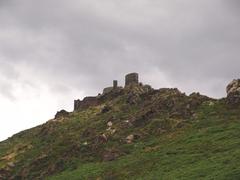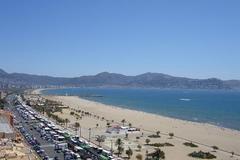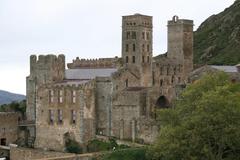
Santa Maria de Roses Visiting Hours, Tickets, and Travel Guide
Date: 03/07/2025
Introduction to Santa Maria de Roses and Its Historical Significance
Santa Maria de Roses, nestled within the fortified walls of the Ciutadella de Roses in the picturesque town of Roses, Catalonia, offers an immersive journey through Mediterranean history and architecture. Recognized as the earliest known example of Lombard Romanesque architecture in Spain, this ancient Benedictine monastery is a testament to Roses’ layered past—from its Greek origins as the colony of Rhode, through Roman occupation, medieval monastic life, and Renaissance military fortification. The site’s integration within the Ciutadella de Roses, a Renaissance-era fortress, encapsulates over two millennia of Mediterranean civilization, with Greek, Roman, Visigothic, and medieval remains (Patrimoni Gencat; Visit Costa Brava).
This comprehensive guide explores the historical evolution, architectural details, and practical visitor information for Santa Maria de Roses and the Ciutadella complex. Whether you are interested in Romanesque art, visiting hours and ticketing, or nearby attractions such as the Castell de la Trinitat and the Monastery of Sant Pere de Rodes, this resource will help you plan your visit.
Historical Overview
Early Origins: Greek and Roman Foundation
Roses traces its origins to the ancient Greek colony of Rhode, established as early as the 8th century BCE by settlers from Rhodes or later by Greeks from Massalia (modern Marseille), possibly allied with Emporion (Empúries) (Greek World Media; Ancient Origins). The Gulf of Roses’ strategic location made it a vital trading hub, fostering cultural and commercial exchanges between Greeks and the indigenous Iberians.
Archaeological remains of the Greek settlement—including coins and urban structures—can be found within the Ciutadella de Roses, alongside significant Roman occupation layers from the 2nd century BCE. A paleochristian church and necropolis further illustrate the site’s continuous religious and cultural evolution (Patrimoni Gencat).
Medieval Revival: The Birth of the Monastery
After the decline of Roman power, Roses experienced renewal during the early Middle Ages. The Benedictine monastery of Santa Maria de Roses was established on the ruins of the ancient Greek city, with the earliest recorded mention in 944 CE. Monastic activity may have begun sooner, likely linked to the influential Monastery of Sant Pere de Rodes (Wikipedia; Visit Costa Brava). Charlemagne’s conquest brought stability, allowing the Benedictine monks to found Santa Maria de Roses around 960 CE.
By the 11th century, the monastery flourished economically, enabling an expansion and the construction of a new church, consecrated in 1060. The abbey’s jurisdiction was shared with the counts of Empúries, reflecting the region’s feudal and ecclesiastical complexity (Greek World Media).
Architectural Significance
Santa Maria de Roses is the oldest known example of Lombard Romanesque architecture in Spain (Wikipedia). The church was built on a basilica plan with three naves, a transept, and three apses. The nave features a barrel vault, and the interior is adorned with blind arches characteristic of the Lombard style. Remnants of the cloister and other monastic buildings are still visible, offering insights into medieval monastic life and architectural practice. Restoration efforts in the late 20th century have preserved these unique features (Wikipedia).
Turbulence, Decline, and Abandonment
Santa Maria de Roses faced repeated threats from the 10th century onward, including Saracen pirate attacks and later wars and plagues. In 1588, a severe plague led to abandonment and looting. By 1592, the monastery’s independence ended with its merger into Santa Maria d’Amer. The French siege during the Great War (1793–1795) caused further destruction, leading to prolonged neglect until restoration began in the 20th century (Wikipedia; Visit Costa Brava).
Integration into the Ciutadella de Roses
Santa Maria de Roses now lies within the Renaissance pentagonal fortress of the Ciutadella, constructed in the mid-16th century to defend against pirates and Turkish attacks (Patrimoni Gencat; Ancient Origins). The Citadel contains layers of Greek, Roman, Visigothic, and medieval history. The on-site Museu de la Ciutadella offers interpretive displays and activities for all ages (Patrimoni Gencat).
Architectural and Cultural Details
Romanesque Lombard Features
Santa Maria de Roses exemplifies the first Romanesque (Lombard) style in Spain, noted for its simplicity, solidity, and decorative Lombard bands and blind arcades. The basilical floor plan—with three naves, a transept, and three apses—emphasizes the liturgical focus and Italian influence (ca.wikipedia.org).
Monastic Complex and Defensive Structures
The site originally included a cloister, monastic buildings, and a defensive wall. The construction of the Ciutadella in the 16th century enveloped the monastery, creating a unique combination of religious and military architecture (ca.wikipedia.org).
Restoration and Conservation
After centuries of decline, extensive archaeological work and restoration in the late 20th century stabilized and partially reconstructed Santa Maria de Roses, including the central apse and main portal. The site is now protected and accessible as part of the Museu de la Ciutadella de Roses (ca.wikipedia.org).
Cultural and Artistic Significance
Santa Maria de Roses played a pivotal role in the region’s religious, economic, and social life, influencing the spread of early Romanesque forms throughout Catalonia. Decorative elements—like Lombard bands—demonstrate the transmission of artistic ideas from northern Italy to the Iberian Peninsula (ca.wikipedia.org).
Practical Visitor Information
Location and Access
Santa Maria de Roses is located within the Ciutadella de Roses, at Av. de Rhode, s/n, 17480 Roses, Girona, Spain (Trek Zone). The site is easily accessible from the town center, with ample nearby parking.
Opening Hours
- April to October: Tuesday to Sunday, 10:00 AM – 7:00 PM
- November to March: Tuesday to Sunday, 10:00 AM – 5:00 PM
- Closed on Mondays and major holidays
Hours may vary on holidays. Always check the official website or local tourism office before your visit.
Tickets and Admission
- Adults: €6 (some sources list €4–€5)
- Reduced (students, seniors): €4
- Children under 12: Free
- Family and group discounts available
Tickets can be purchased onsite or online. Guided tours are available for an additional fee (ca.wikipedia.org).
Accessibility
The site offers wheelchair access to main areas, though some uneven terrain exists. Ramps and accessible pathways are provided in key sections.
Guided Tours and Visitor Facilities
Guided tours are offered in English, Spanish, and Catalan, providing historical and architectural insights. The visitor center offers displays, maps, and brochures. Facilities include restrooms, a café, and a gift shop.
What to See and Do
- Explore the Monastic Ruins: Examine the church nave, apse, and cloister remains, with informational panels on construction and monastic life (Trek Zone).
- Discover the Ciutadella Complex: The fortress features star-shaped bastions and layers of Greek, Roman, and medieval remains (Fascinating Spain).
- Nearby Historical Sites:
- Castell de la Trinitat: 16th-century fortress with panoramic views (Trek Zone).
- Sant Pere de Rodes: Renowned Benedictine monastery in the Cap de Creus mountains.
- Basílica de Santa Maria de Castelló d’Empúries: The “Empordà Cathedral.”
- Cap de Creus Natural Park: For hiking and Mediterranean landscapes (Fascinating Spain).
Cultural Insights and Local Experiences
- Local Traditions: Santa Maria de Roses features in local festivals, concerts, and exhibitions.
- Gastronomy: Enjoy seafood cuisine and “suquet de peix” paired with Empordà wines in Roses’ old town (Fascinating Spain).
- Travel Tips: Visit early or late in the day for the best light and fewer crowds. Combine your visit with a stroll along the promenade or a swim at the beach.
FAQ: Santa Maria de Roses & Ciutadella de Roses
Q: How long does a typical visit take?
A: 1–2 hours for the monastery and museum.
Q: Is photography allowed?
A: Yes, for personal use. Drone and commercial use require authorization.
Q: Are pets allowed?
A: Only service animals are permitted.
Q: Is there parking?
A: Yes, ample parking near the Ciutadella.
Q: Are there guided tours in English?
A: Yes, available in English, Spanish, and Catalan.
Q: Is the site wheelchair accessible?
A: Partially; main areas have ramps, but some uneven terrain remains.
Enhance Your Visit
- Visuals & Maps: High-quality images and maps are available at the entrance and online. Virtual tours are also offered (Patrimoni Gencat).
Summary and Recommendations
Santa Maria de Roses is a must-see for history and architecture enthusiasts, offering a unique window into Catalonia’s past—from Greek foundation to Romanesque splendor and Renaissance fortification. The combination of well-preserved ruins, modern visitor amenities, and a dynamic calendar of events makes it ideal for families, history buffs, and casual tourists alike. Its proximity to other attractions and natural parks ensures a full and memorable experience in Roses.
For the latest updates, tickets, and guided tours, consult the Museu de la Ciutadella de Roses and Visit Costa Brava. Download the Audiala app for personalized audio guides and travel info.
Useful Links and References
- Santa Maria de Roses: A Historic Jewel Among Roses Historical Sites — Visiting Hours, Tickets, and Travel Tips, 2025, (Patrimoni Gencat)
- Santa Maria de Roses Visiting Hours, Tickets, and Historical Guide to Roses, Catalonia, 2025, (ca.wikipedia.org)
- Ciutadella de Roses Visiting Hours, Tickets, and Must-See Historical Attractions in Roses, 2025, (Visit Costa Brava)
- Santa Maria de Roses Visiting Hours, Tickets, and Guide to Roses Historical Sites, 2025, (Trek Zone)
- Santa Maria de Roses Origins and History, 2017, (Greek World Media)
- History of Roses and Ciutadella, 2025, (Visit Roses)
- Fascinating Spain: Things to Do in Roses Costa Brava, 2023, (Fascinating Spain)
- Ancient Origins: Rhodes in Spain, 2019, (Ancient Origins)
Plan your visit and experience the enduring spirit of Santa Maria de Roses and the vibrant heritage of Roses, Catalonia!





